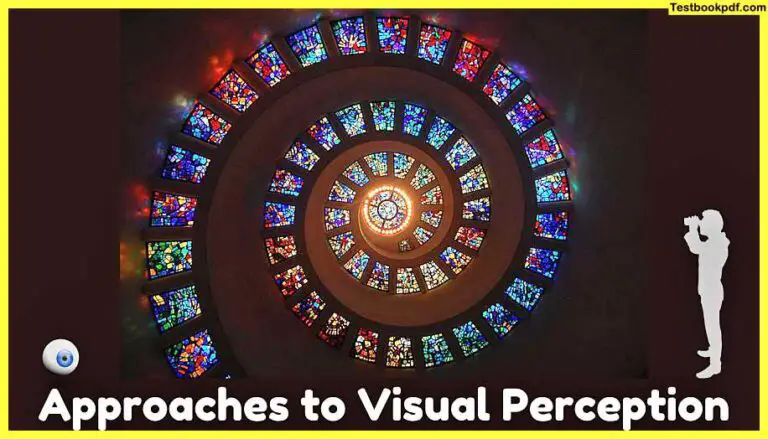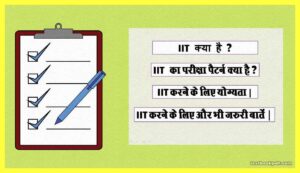Approaches to Visual Perception Pdf (J.J Gibson’s theory)
In this article, we will talk about J.J Gibson’s theory of perception, Approaches to Visual Perception Pdf (J.J Gibson’s theory), and his ecological approach. What is the goal of perception? Is it meant for action or recognition? Whether perception depends on top-down or bottom-up processing? We will focus on these questions in the following articles by discussing various approaches.
Approaching Perception – Key Questions
Before we begin with that let us talk about why we need to discuss these approaches to perception in the first place, the key question in perception basically is what is perception really meant why we need to perceive the world and what benefits it gives us and what is our perspective towards perception as a cognitive function.
The question one might ask is what is the goal of perception is it for action or is it for recognition i can actually illustrate the difference between action and recognition by just throwing a ball at you and you probably first take evasive action you will try and save yourself from being hit by the ball then really recognizing that what was this object that i threw towards you this kind of tells us that we look at the world we are interacting with this world are we perceiving this world more importantly to interact with this not really merely just to get visual description of the environment we live in that’s also useful and that’s also something which perception is there for but there is this debate between what is the actual use of perception is it for interacting with this world or is it for just having a visual description of this world ok we are talking about visual perception more specifically but such a question can also be asked for other modalities of perception like auditory perception tactile perception and other other kinds of perception.
There is always there is already evidence for the fact that perception for action and perception for recognition are actually different processes and they basically involve different regions of the brain this was the research done by Milner and Goodale in around 1998 and a lot of papers and lot of experiments after that have actually confirmed this idea so if you have this in background.
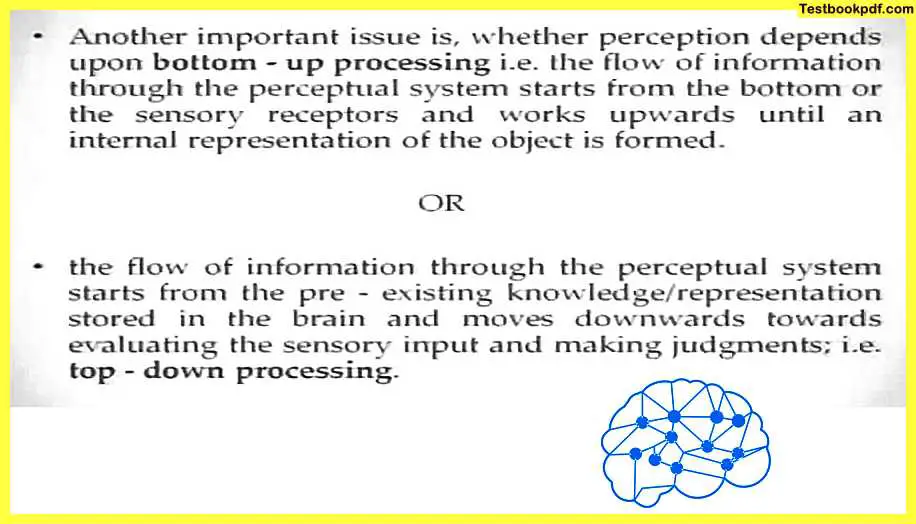
And if you really try and look at the last article in this series we were talking about representation and what is a representation meant for and why do we construct representation basically how do we construct representations then you will come to an actual difference between the way perception can be constructed say for example weather perception depends on bottom-up processing that is basically the flow of information through the perceptual system starts from the bottom of sensory receptors and works upwards until an internal representation of the object that is formed or the flow of information through the perceptual system starts from pre-existing knowledge like your memory stored in the brain and then it moves downwards towards evaluating whatever sensory inputs you’re getting.
Gibson’s Theory of Perception – The Ecological Approach
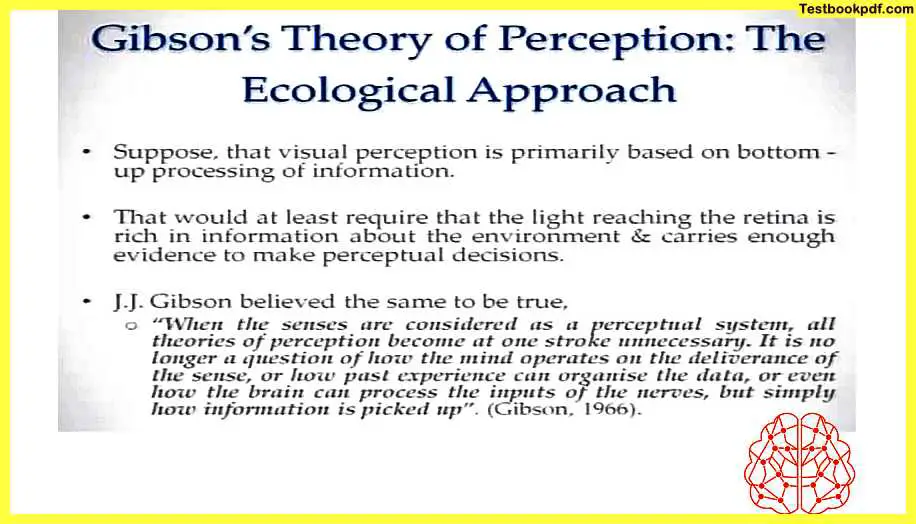
So, these are the two routes we discussed yesterday on how mental representations are constructed and this is in that sense actually one of the critical questions in how perception can be looked at we will talk about one of these very important theories of perception put forward by j.j Gibson and this theory of perception is called the ecological approach we will talk about why ecological in a short while but let us say suppose that the visual perception is primarily based on the bottom-up crossing of information ok so whatever mental representations of this world you are going to construct will be basically built out of whatever sensory experience you are getting j.j Gibson actually believed that this is how we perceive this inner world this external world and he said something to the order of when the senses are concerned are considered as a perceptual system all the theories of perception become at one stroke unnecessary you don’t really need to specify the analytical processes.
It is no longer a question of how the mind operates on the deliverance of the sense or how past experience can organize this data or even how the brain can process the inputs of the nerves but simply how is information picked up from this external world via these senses so JJ Gibson basically believes that the mental representations that we construct in perception are entirely made out of the sensory experience that is delivered by each of our senses we are talking more specifically in this sense about the visual perception the Gibsonian approach concentrates on the information present in the visual environment.
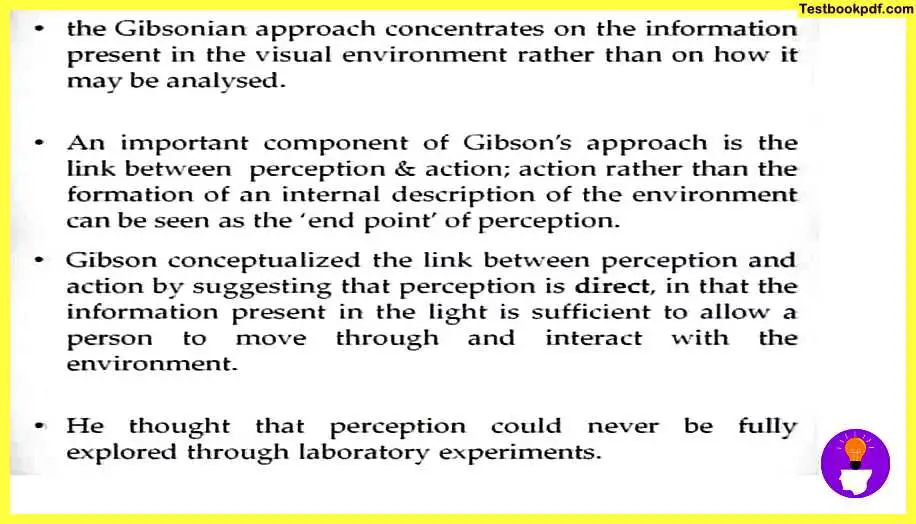
Rather than how the brain or the mind operates upon it an important component of Gibson’s approach is the link between perception and action he believed that action rather than the formation of the internal description of this environment should be seen as the end point of perception Gibson also conceptualized the link between perception and action by suggesting that perception is direct in that the information present in the light is enough it’s sufficient to allow a person to move through and interact through the environment so it is it does not really need any kind of intermediary processes or transformations to happen it’s just that the light that actually falls on your retina is sufficient to give you enough information to do both either get the description of the world and to be able to interact with it he thought that perception could never be fully explored through laboratory experiment and one of the reasons was that if you see a picture like this.

It is still at the end of the day a picture does not carry all the information that if you have kept the real object would carry so he kind of emphasized this difference and he said further that.
And because of the importance that he gave to the real world and because of the emphasis he placed on conducting real experiments his approach was called the ecological approach he referred to theories that were based on artificial experiments employing these two-dimensional shapes as theories in the air while he referred to his own theory as a ground theory because he was actually conducting experiments in the real scenario and interacting with real objects and looking at real scenes etc.
As it emphasized the role played by the real and textured surface of the ground in providing information about the distance which is one of the reasons why his theory was called the ground theory the most important concept in Gibson’s approach to perception is this concept of the optic array.
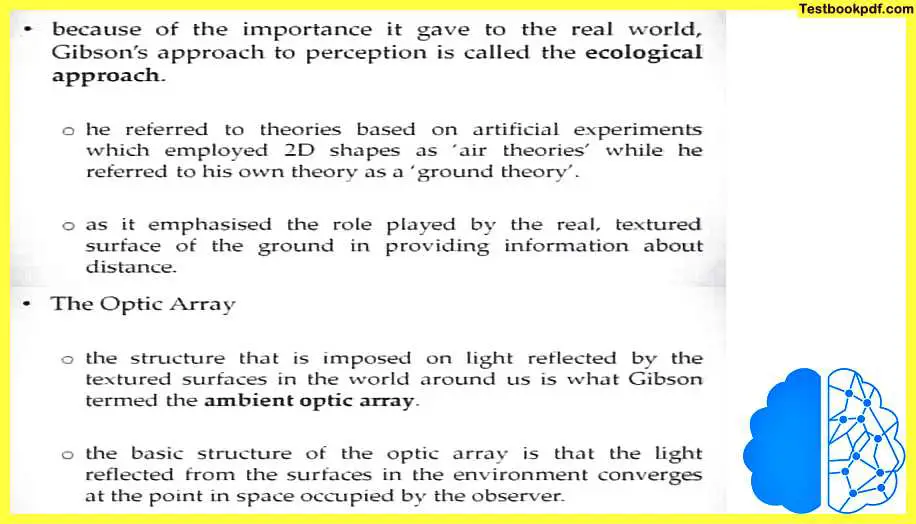
Optic Array
The optic array basically is the structure that is imposed on the light reflected by the textured surfaces in the world around us that is basically what this optic array contains of the basic structure of the optic array basically is the light reflected from the surfaces in the environment and that light converging at a point in space that is occupied by the observer so imagine myself sitting in this room and I am actually there is a lot of light in this room there is light is reflecting from the screens from the cameras from these walls so all of this light converging towards my eyes is basically what the ambient optic array is about.
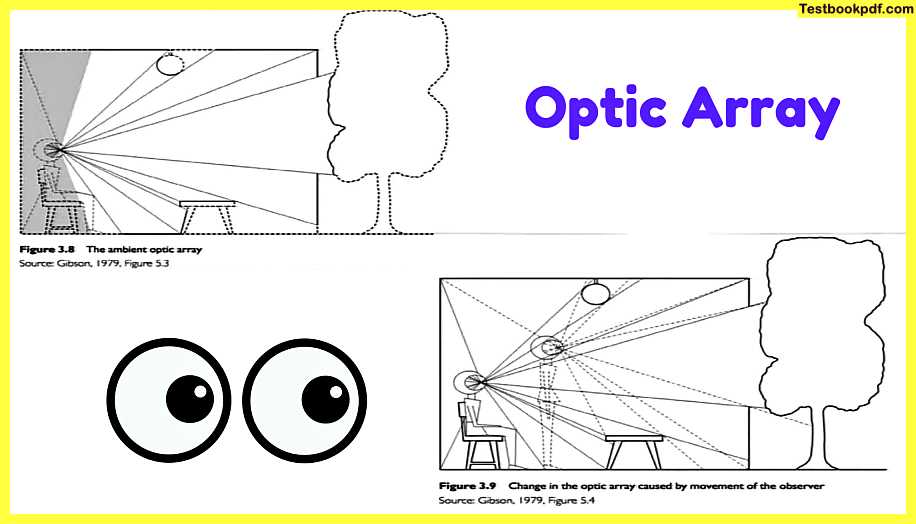
You can see, the figure is given below, this kind of demonstrates an observer sitting in a particular room and light reflecting from various surfaces in the room and then converging on the point in space where this observer’s eyes are located.
But the observer is really starting we are not really always sitting we are actually moving we are moving our head we are moving our eyes so this is also something that Gibson took into account and he said that because of these sources of motion the position of the head with respect to the eye is always altered and the optic array also changes accordingly.
So, here is the demonstration of the fact that say for example if this individual is now standing or say for example if this individual is walking in the room the structure of the ambient optic array would change accordingly now the primary structure of this optic array what is this the primary structure of the optic array is basically a series of angles that are formed by the light reflecting from various surfaces in the environment towards your eyes say for example an angle may be formed between the light that is reflected from the near edge of a table or from the far edge or from the top of the wall or from the bottom of the wall different ways in addition to this primary structure of the optic area Gibson maintain that there were additional higher-order features that could also provide information unambiguous information basically regarding the nature of the environment.
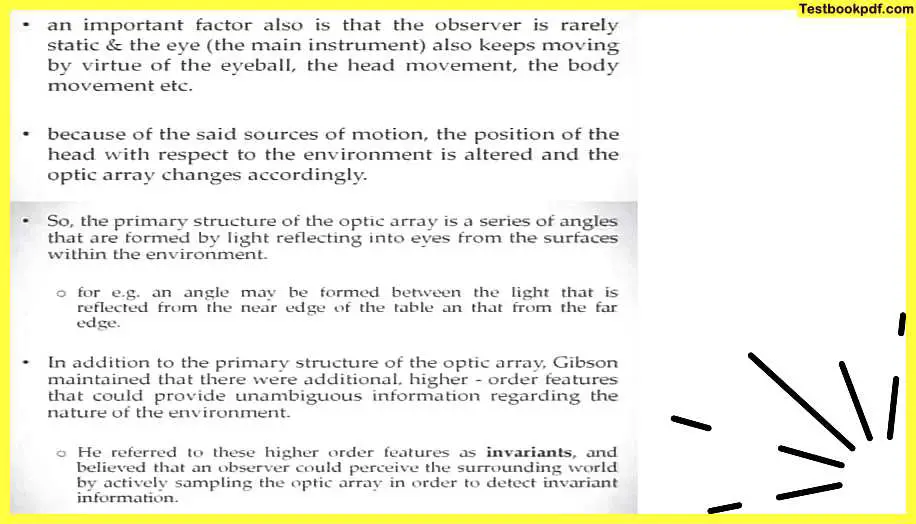
So all of these different structures also tell you and give you rich information about the environment in which you are moving around he referred to these higher order features as invariants things that do not really change because those could be things that are static and he believed that an observer could perceive the surrounding world by an actively sampling this optic array in order to detect invariant information so if you are actually at a place in the room you would get particular information about the surroundings about the objects in the room from examining these invariant features as well.
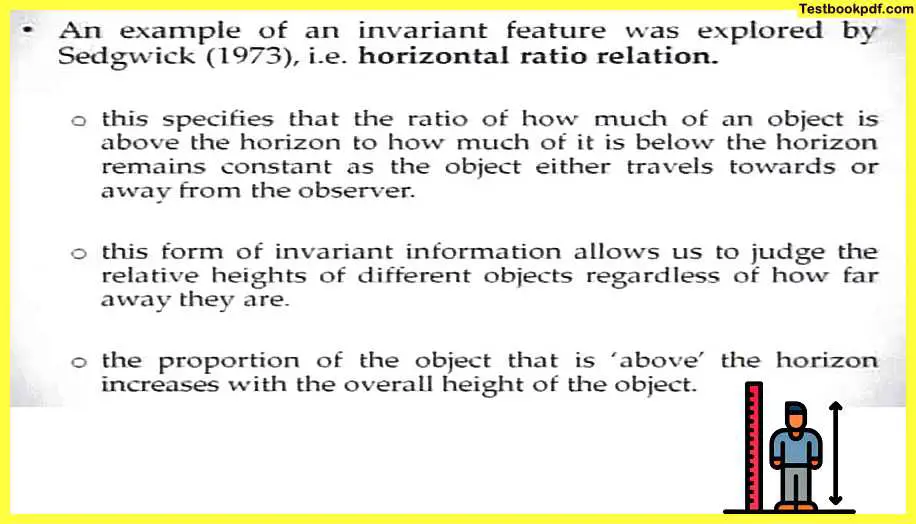
An example of an invariant feature was explored by Sedgwick in 1973 and this invariant feature was a horizontal ratio relation
What is the horizontal ratio relation?
basically, it specifies that the ratio of how much of an object is above the horizon to how much of an object is below the horizon is always constant as the object either travels towards or away from the observer so suppose I’m standing at this end of the room there’s somebody standing at the far end and the person is moving towards me or the person is moving away from me this ratio of how much of this person is above the horizon versus how much of this person is below the horizon is going to be constant.
This form of invariant information allows us to judge the relative heights of different objects and people regardless of how far away from them is this proportion of the object above the horizon increases with the overall height of the object letting us see a picture that will explain you this.
So here you can see people of the same heights and as they are actually from at a diff at different distances from us so there in the first figure it’s just near us then and the second figure is one meter away from us and the third it’s 10 meters away from us and the fourth one is around 20 meters away from us you see that this relationship is changing but the ratio is constant.
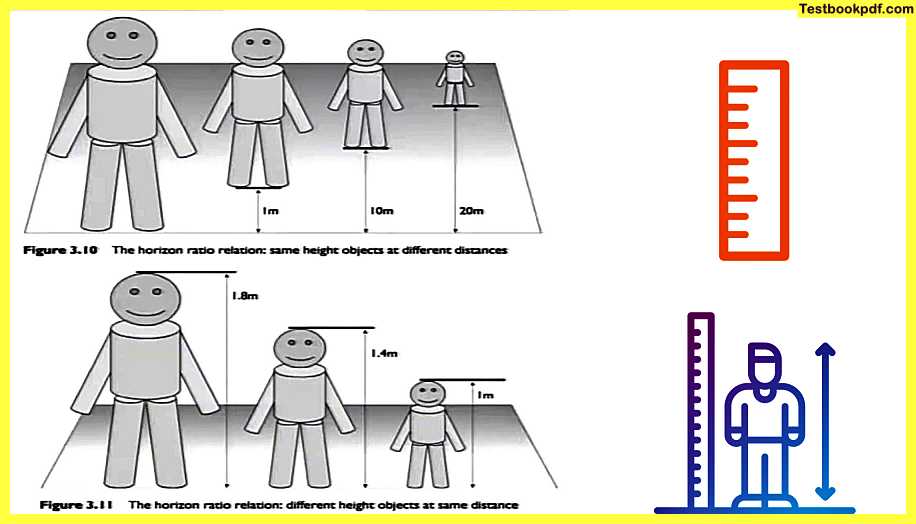
Here you can see people of different heights at the same distance and you can again see that this horizontal ratio relation is constant now another important source of invariant information in Gibson’s theory is the texture gradient what is the texture gradient there are three forms of texture gradient relating to density perspective and compression of these textured elements texture is supposed to be the exact nature of the say for example of different surfaces how does one surface differ from another.
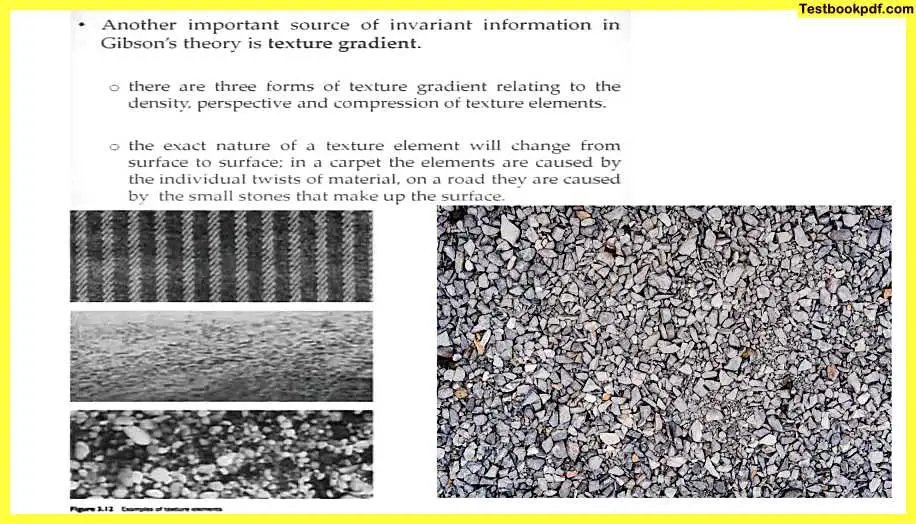
See for example in a carpet the elements are caused by individual twists of the material the threads with which the carpet is made up of on a road the texture is basically formed by these small stones that are combined to make up that surface so that is basically what surface is about and that is the idea of what texture means here you can see what is you can see in the bottom you can see pebbles on the beach in the middle you can see probably a tart road in the top you can see how a carpet is made or maybe a shawl or something like that.
In making use of these texture gradients we assume that the texture of the surface is uniform so you make this assumption that the entire surface will have the same kind of texture and then you use this information to make judgments about what maybe judge about different things from the surface let us take an example the surface of the road consists of stones similar in size throughout its length and therefore any change in the apparent nature of the texture provides us with information about regarding the distance orientation and the curvature of the surface that is the route.
Imagine say for example you’re riding a bike and you’re actually on a very nice road made with similar size stones and in a long distance you will you might notice that sometimes the road appears to be converging or it appears to be diverging and this information about distance if there are no other queues available, can actually be really important for you to guess how far you are from a particular milestone and those kinds of things.
What do we do using these texture gradients?
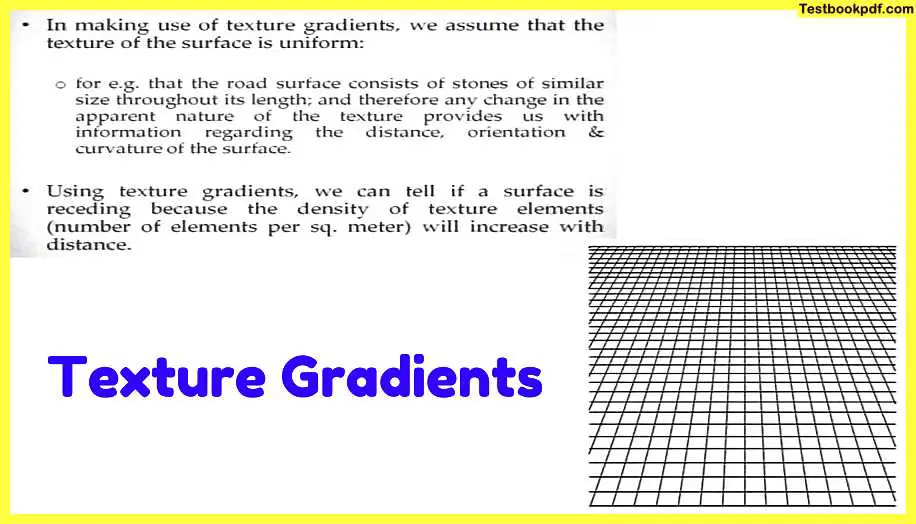
We can actually tell if a surface is receding that is moving away from us or if it is actually coming closer let us take this example if you see the texture of these tiles here you can see that the tiles closer to us say for example appear much bigger the styles which are further from us appear slightly smaller we know for a fact that all of these styles all of these square boxes are actually of the same size so we are using this information about the size of the tiles to actually make a judgment about whether which part of the tile is closer to us or which part of the tile is further to us these kinds of things are used very cleverly by painters to create illusions of distance etc.
In a similar way, the perspective gradient and the compression gradient perspective gradient is the width of the individual elements, and the compression gradient is the height of the individual elements both of these can reveal the shape and the orientation of the surface.
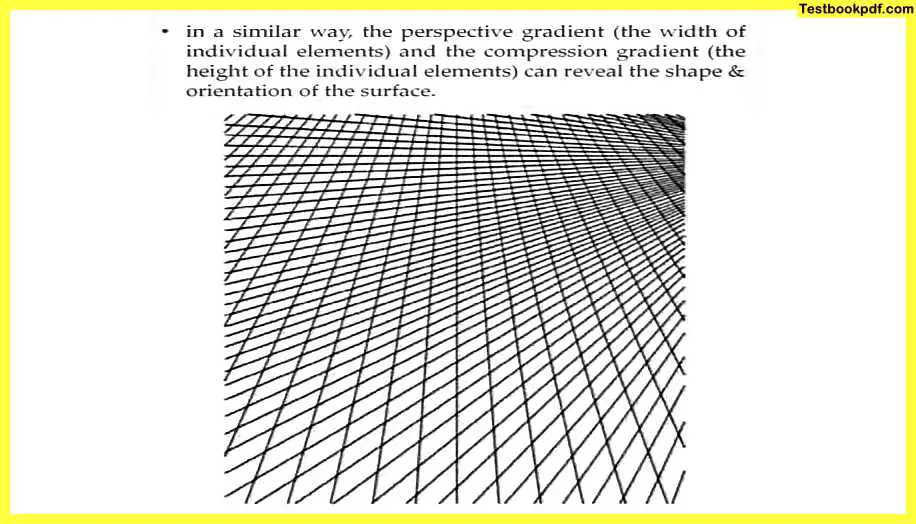
I’ll take another similar example you can see towards the right side everything is slightly compressed the width is reducing so you get a piece of information about the perspective and say for example you can get the information about the shape and if you see in the left side of the image you can get the perspective about the orientation of the surface.
So you use this information present on the surface to actually judge the nature of the surface or actually more importantly about your position in relation to this particular surface now another important concept in Gibson’s ecological approach is basically this concept of flow Gibson says that what is clear to me now that was not clear before is that the structure as a frozen structure is just a myth or at least it’s a limiting case in a variance of structure do not really exist except in relation to variance let us try and understand what he is trying to say here he saying frozen structure static structures are not really the thing we are always moving or objects in the environment are mostly moving and in that sense to have this concept of motion and how this motion changes your relationship to the different surfaces etc or objects in the environment.
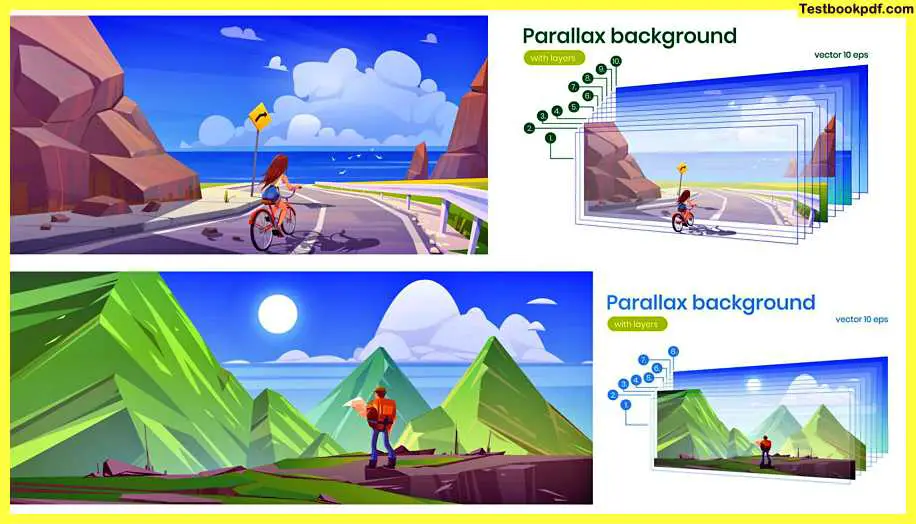
So motion is an important aspect of the visual world by virtue of which the environment changes over time or the way you see the environment changes over time there are two primary forms of movement motion of the observer if you are moving around and motion of the objects within their suppose you are sitting in a park and a lot of children are playing suppose you are actually standing in the balcony and you see a lot of vehicles moving by the motion of the observer tends to produce the greatest degree of movement as the entire optic array needs to be transformed so if you’re moving your head if you’re moving yourself then whatever the angles of that are contained in the slide with this light reflecting from so many surfaces and so many objects in the environment all of this needs to change at once if say for example the objects in the external world are moving minute adjustments with relation to those particular objects might be required.
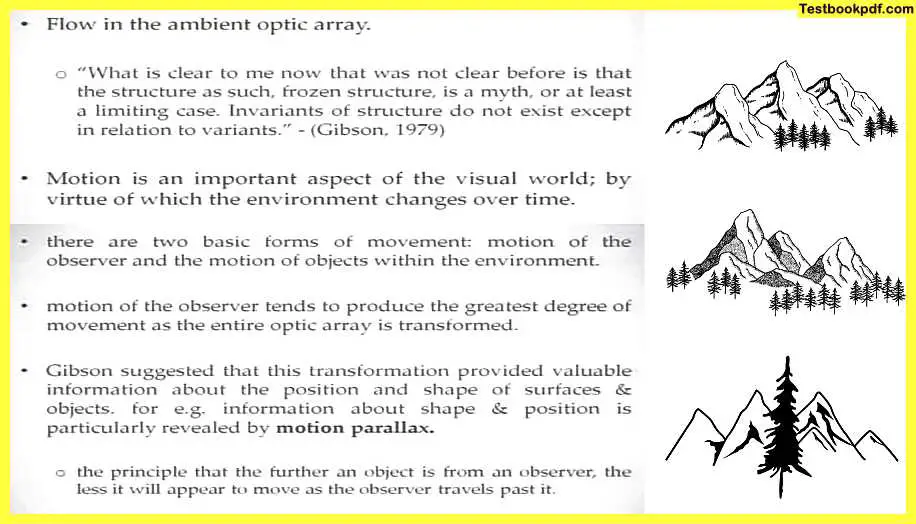
Now Gibson suggested that this transformation if you are moving, provides valuable information about the position and shape of surfaces and objects in this external world for example an interesting cue could be information about a shape and position that is revealed by something called motion parallax now
What is motion parallax?
motion parallax is basically the principle that the further an object is from an observer the less it will appear to move as the object appear comes closer to us it kind of the motion of the object becomes more pronounced well you’re put in charge of a moving train and you’re looking outside of your window and you’re trying to make sense of the environment around you you’re passing by a field and you look at a herd of cows grazing in a large field next to the railway line the cows near the track will appear to move fast much move past much faster than the cows at the back of the field.
This it is not really necessary that those cows are running and the other one so static is basically because you moving faster and the cows which are nearer that is why they appear to move past faster thus this degree of apparent motion is directly related to the distance of this object from the observer of the cow from the driver.
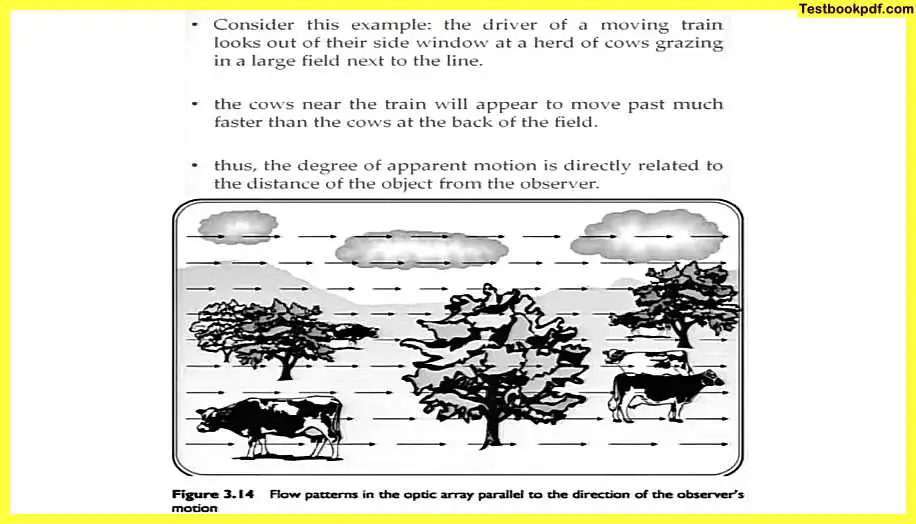
You can see this figure here you can see that if you are passing by and you are looking at your left you are seeing that this flow is from the left to the right and you are looking at the field you are probably you will find out that the fourth cow which is furthest will appear to be not moving even irrespective of whether it is moving or not and the cow which is closest to the observer appears to be moving much faster.
A second means by which observer motion can provide information about the shape and position of objects is through occlusion, occlusion is basically when something is hidden or occluded by something else ok so imagine the same observer the train driver that is traveling past the same field of cows and the motion will cause the cows nearest to the nearest to pass in front of or occlude the cows glazing further.
If you go back to this figure you will see that the second and the third cows are more towards the right the third cow is actually slightly occluded by the second cow this aspect of occlusion gives you an estimate that the third cow is slightly further away from the second cow this is something which you can actually make up very easily so the all this allows the observer to deduce that occluded cows are farther away from those that are actually doing this occlusion.
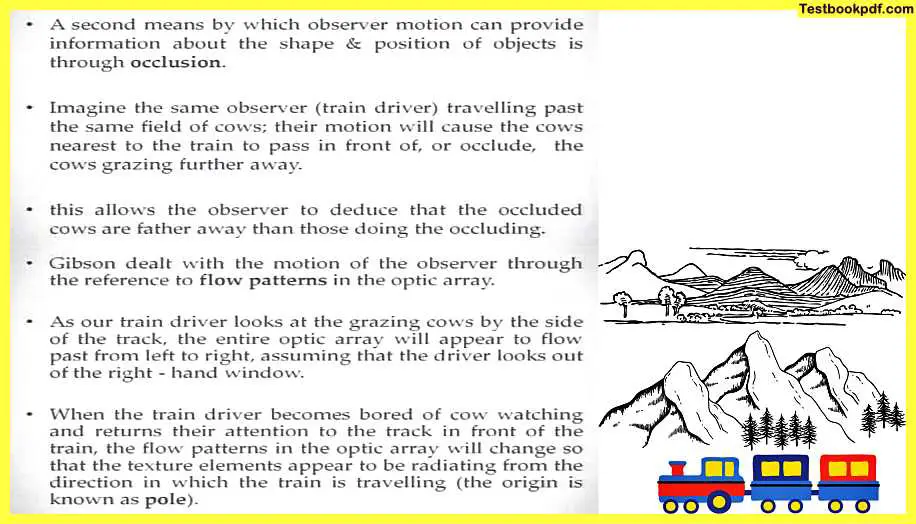
Now Gibson dealt with this motion of the observer through the reference to flow patterns in the optic area so he says that there are patterns of flow in the optic array flow is basically just movement now say for example again coming back to the strain driver example suppose the train driver is now bored at looking at by looking at the sides he is now looking he comes in the front of the locomotive and he is just looking further in the direction to which the train in the direction in which the train is moving.
Now this entire arctic optic array will now appear to flow past from the left to right assuming that the driver looks out of the right-hand window now when the driver is in the front the flow patterns in the optic array will change such that the texture elements that information in the surface will appear to be reading from the direction in which the train is traveling.
So it will appear like say for example you’re moving in a particular direction and all the light is diverging from that direction this point for this in the direction is referred to as the pole so if you are actually moving ahead and you’re looking right in front of you you will see that this there is a point called the pool and all the light is kind of diverging from it here is a figure which is even which is demonstrating this say for example maybe the driver kind of comes.
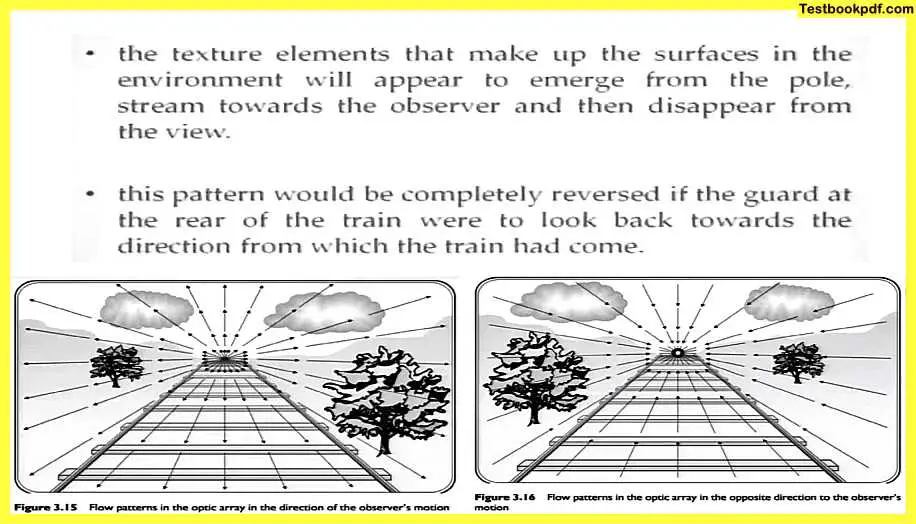
At the back of the train now the texture levels elements that will that appear to make up the surface in the environment will kind of appear to Yeso this pattern Yei talked about this already so this pattern will completely get reversed if the guard at the rear of the train if the guard comes at the rear of the train and is trying to look backward in the direction from which the train had come that will basically lead to convergence of this light the convergence pattern of there so you actually.
Now in this figure, you’re moving away from this direction and you’ll see everything is converging towards the pole so if you just look at these figures this one is when you’re actually moving towards the pole this one here is when you’re moving away from the pole, the pole is any point at the furthest distance to the direction in which you are moving.
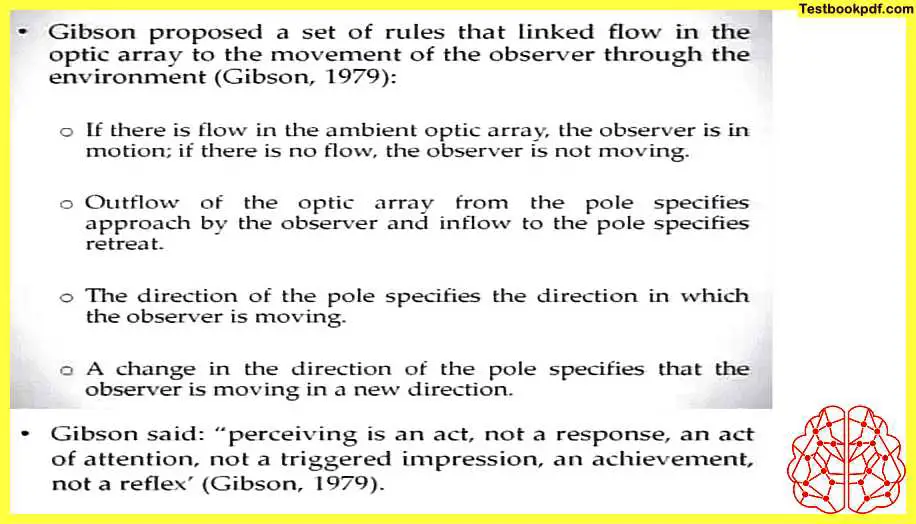
Now, Gibson, proposed a set of rules that linked flow in the optic array to the movement of the observer through this environment if the observer is moving through the environment you can deduce a few things by observing the flow in the optic area these rules are basically so if there is flow in the ambient optic array the observer is moving if there is no flow the observer is not moving that is understood outflow of the optic array from the pole specifies that you are approaching this point inflow to the pole specifies that you are moving away from a particular point.
The direction of the fold specifies the direction in which the observer is moving so if the direction is basically right in front of you you are moving towards it if the if the direction of the pole is at the back then you are actually receding from it a change in the direction of the pole specifies that the observe is now change direction now so this was about motion this was about earlier we talked about perspective horizontal ratio relation so we’ve talked about how this ambient optic array changes or how this ambient optic array basically is restructured in light of new information with the with respect to the environment.
As I began saying, Gibson believed that perception is is an act it is an action and it is not really merely a passive response ok it is basically an act of attention you choose and you select to attend aspects of the environment while you are not really concerned about all the other parts. So, it’s not really a triggered impression it’s an achievement it’s not really a reflex he is basically telling us that you are actively involved in perception that is you are looking for information with which or on which you will interact.
Affordance and Resonance
This brings us to the concept of affordance Gibson basically took this idea of information being picked up further by stating that the end point of the perceptual processes was not the visual description of the surrounding world but rather that the objects would directly afford their use so when you once you look at the object there is enough information in light emanating from that object that will tell you about how to use that particular object that is what Gibson actually meant.
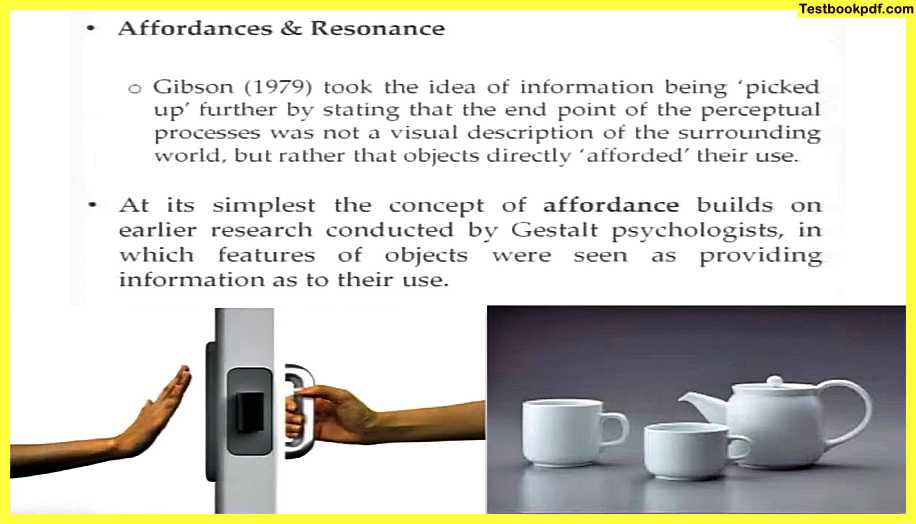
So at its simplest, the concept of affordance builds on earlier research done by gestalt psychologists will talk about them in due course basically which says that features of objects actually provide information as per or regarding their use if you see the door the two surfaces of the door here one of the surfaces has an angle it affords holding it, it affords to take a grip of it while the other surface of the door does not have a handle so it kind of affords you pushing through it ok so you look at the surface you realize what how do you interact with the surface and that is how you make out whether you will pull it or say for example whether we grip the handle or you just push the throat to the through your palm.
Again different kinds of handles can afford different kinds of grip formation and again this is basically also derived from the light emanating from these objects so you automatically modulate the aperture of your fingers and you try and hold these different figures.
Gibson further claims that affordance acts as a bridge between perception and action and that affordance does not require the intervention of any cognitive processes so he says information or information or that the light emanating from all of these surfaces is enough for a person to be able to act and interact with the object act on these objects or interact with this environment there is no rule of memory imperception according to Gibson and he says that the observer does not really need to consult prior experience in order to be able to interact with the world ok he says there is already enough information in the world already enough information in the light that is being reflected from the world the light that he called the ambient optic array.
So he’s strictly this approach is strictly bottom-up approach it’s kind of building up from whatever the sensory experience is gained by your eyes he says for example that the system resonates to the invariant information in the ambient optic array meaning probably that global information about the optic array is dealt with by the perceptual system without the need to analyze more local information such as lines energy so he said this global information about this light reflected from these edges and the surfaces is more than enough now that was mostly what Gibson was saying nowadays experiments using dynamic naturalistic stimuli can be done.
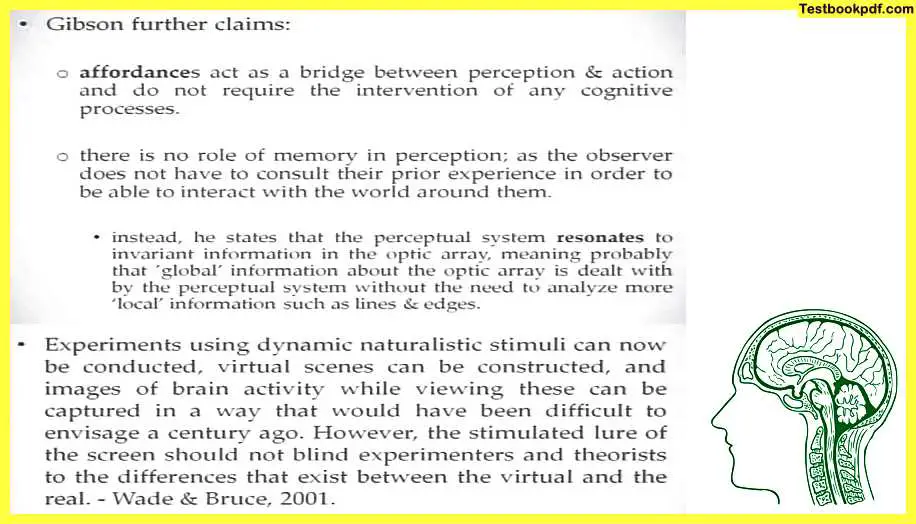
Virtual scenes can be constructed and images of brain activity, while people are viewing these scenes or viewing these objects, have also been captured in a way that would have been difficult to even think of in the time that Gibson was around however the stimulated layer of the screen should not really blind experimenters and theorists to this difference between the real scenario and the scenic scenario that you construct that we construct in our labs this is something you can take off from Gibson’s analysis on perception he says that there is much more information in the real world in when you are actually interacting with the environment than if you trying to study the process of perception by conducting experiments in our labs where you are basically projecting these stimuli on two-dimensional screens.
Now to sum up whatever we have talked about Gibson we basically talked about the ecological approach and we talked about how Gibson suggests that the light array from this external world may be sufficient to provide us with a rich source of information to really construct very rich mental representations of this external world we also saw that Gibson actually emphasized that perception is more for action rather than just the description or recognition of this visual world thank you in the next article we will talk about another approach on visual perception.
Read also:
Representation In Perception Psychology
Physiology of Visual Perception pdf (vision perception)
Click here for Complete Psychology Teaching Study Material in Hindi – Lets Learn Squad
